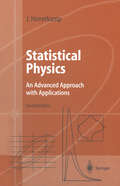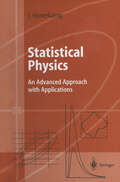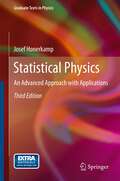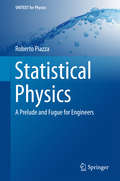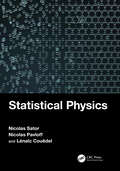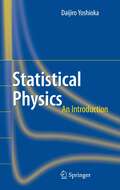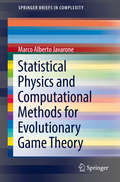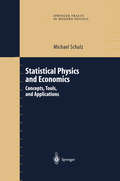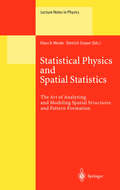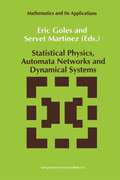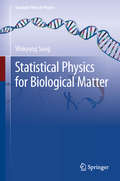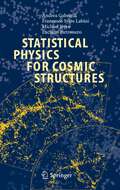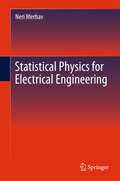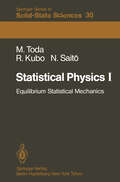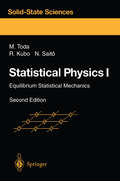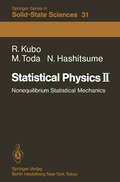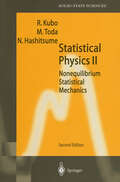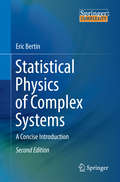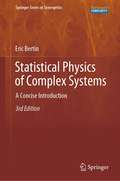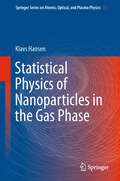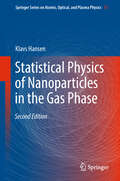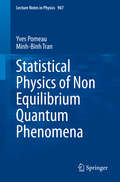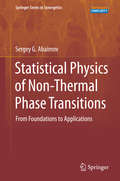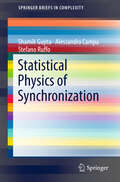- Table View
- List View
Statistical Physics: An Advanced Approach with Applications Web-enhanced with Problems and Solutions (Advanced Texts in Physics)
by Josef HonerkampThe book is divided into two parts. The first part looks at the modeling of statistical systems before moving on to an analysis of these systems. This second edition contains new material on: estimators based on a probability distribution for the parameters; identification of stochastic models from observations; and statistical tests and classification methods.
Statistical Physics: An Advanced Approach with Applications
by Josef HonerkampStatistical Physics offers an advanced treatment with numerous applications to modern problems of relevance to researchers and students. Supplementing the concepts and methods employed in statistical mechanics, the book also covers the fundamentals of probability and statistics, mathematical statistics, and stochastic methods for the analysis of data. It is divided into two parts, the first focusing on the modeling of statistical systems, the second on the analysis of these systems.
Statistical Physics: An Advanced Approach with Applications (Graduate Texts in Physics)
by Josef HonerkampThe application of statistical methods to physics is essential. This unique book on statistical physics offers an advanced approach with numerous applications to the modern problems students are confronted with. Therefore the text contains more concepts and methods in statistics than the student would need for statistical mechanics alone. Methods from mathematical statistics and stochastics for the analysis of data are discussed as well. The book is divided into two parts, focusing first on the modeling of statistical systems and then on the analysis of these systems. Problems with hints for solution help the students to deepen their knowledge. The third edition has been updated and enlarged with new sections deepening the knowledge about data analysis. Moreover, a customized set of problems with solutions is accessible on the Web at extras.springer.com.
Statistical Physics: A Prelude and Fugue for Engineers (UNITEXT for Physics)
by Roberto PiazzaThis book, provides a general introduction to the ideas and methods of statistical mechanics with the principal aim of meeting the needs of Master’s students in chemical, mechanical, and materials science engineering. Extensive introductory information is presented on many general physics topics in which students in engineering are inadequately trained, ranging from the Hamiltonian formulation of classical mechanics to basic quantum mechanics, electromagnetic fields in matter, intermolecular forces, and transport phenomena. Since engineers should be able to apply physical concepts, the book also focuses on the practical applications of statistical physics to material science and to cutting-edge technologies, with brief but informative sections on, for example, interfacial properties, disperse systems, nucleation, magnetic materials, superfluidity, and ultralow temperature technologies. The book adopts a graded approach to learning, the opening four basic-level chapters being followed by advanced “starred” sections in which special topics are discussed. Its relatively informal style, including the use of musical metaphors to guide the reader through the text, will aid self-learning.
Statistical Physics
by Nicolas Sator Nicolas Pavloff Lenaic CouedelThis book presents an introduction to the main concepts of statistical physics, followed by applications to specific problems and more advanced concepts, selected for their pedagogical or practical interest. Particular attention has been devoted to the presentation of the fundamental aspects, including the foundations of statistical physics, as well as to the discussion of important physical examples. Comparison of theoretical results with the relevant experimental data (with illustrative curves) is present through the entire textbook. This aspect is facilitated by the broad range of phenomena pertaining to statistical physics, providing example issues from domains as varied as the physics of classical and quantum liquids, condensed matter, liquid crystals, magnetic systems, astrophysics, atomic and molecular physics, superconductivity and many more. This textbook is intended for graduate students (MSc and PhD) and for those teaching introductory or advanced courses on statistical physics. Key Features: A rigorous and educational approach of statistical physics illustrated with concrete examples. A clear presentation of fundamental aspects of statistical physics. Many exercises with detailed solutions. Nicolas Sator is Associate Professor at Sorbonne University, Paris, France. He is a member of the Laboratory of Theoretical Physics of Condensed Matter (LPTMC) and his research focuses on the physics of liquids. Nicolas Pavloff is Professor at Paris-Saclay University, France. He is a member of Laboratoire de Physique Théorique et Modèles Statistiques (LPTMS) and his domain of research is quantum fluid theory. Lénaïc Couëdel is Professor at the University of Sasktchewan, Saskatoon, Canada and researcher at CNRS, France. His research area is plasma physics with a focus on complex plasma crystals.
Statistical Physics
by Nicolas Sator Nicolas Pavloff Lenaic CouedelThis book presents an introduction to the main concepts of statistical physics, followed by applications to specific problems and more advanced concepts, selected for their pedagogical or practical interest. Particular attention has been devoted to the presentation of the fundamental aspects, including the foundations of statistical physics, as well as to the discussion of important physical examples. Comparison of theoretical results with the relevant experimental data (with illustrative curves) is present through the entire textbook. This aspect is facilitated by the broad range of phenomena pertaining to statistical physics, providing example issues from domains as varied as the physics of classical and quantum liquids, condensed matter, liquid crystals, magnetic systems, astrophysics, atomic and molecular physics, superconductivity and many more. This textbook is intended for graduate students (MSc and PhD) and for those teaching introductory or advanced courses on statistical physics. Key Features: A rigorous and educational approach of statistical physics illustrated with concrete examples. A clear presentation of fundamental aspects of statistical physics. Many exercises with detailed solutions. Nicolas Sator is Associate Professor at Sorbonne University, Paris, France. He is a member of the Laboratory of Theoretical Physics of Condensed Matter (LPTMC) and his research focuses on the physics of liquids. Nicolas Pavloff is Professor at Paris-Saclay University, France. He is a member of Laboratoire de Physique Théorique et Modèles Statistiques (LPTMS) and his domain of research is quantum fluid theory. Lénaïc Couëdel is Professor at the University of Sasktchewan, Saskatoon, Canada and researcher at CNRS, France. His research area is plasma physics with a focus on complex plasma crystals.
Statistical Physics: An Introduction
by Daijiro YoshiokaThis book provides a comprehensive presentation of the basics of statistical physics. The first part explains the essence of statistical physics and how it provides a bridge between microscopic and macroscopic phenomena, allowing one to derive quantities such as entropy. Here the author avoids going into details such as Liouville’s theorem or the ergodic theorem, which are difficult for beginners and unnecessary for the actual application of the statistical mechanics. In the second part, statistical mechanics is applied to various systems which, although they look different, share the same mathematical structure. In this way readers can deepen their understanding of statistical physics. The book also features applications to quantum dynamics, thermodynamics, the Ising model and the statistical dynamics of free spins.
Statistical Physics and Computational Methods for Evolutionary Game Theory (SpringerBriefs in Complexity)
by Marco Alberto JavaroneThis book presents an introduction to Evolutionary Game Theory (EGT) which is an emerging field in the area of complex systems attracting the attention of researchers from disparate scientific communities. EGT allows one to represent and study several complex phenomena, such as the emergence of cooperation in social systems, the role of conformity in shaping the equilibrium of a population, and the dynamics in biological and ecological systems.Since EGT models belong to the area of complex systems, statistical physics constitutes a fundamental ingredient for investigating their behavior. At the same time, the complexity of some EGT models, such as those realized by means of agent-based methods, often require the implementation of numerical simulations. Therefore, beyond providing an introduction to EGT, this book gives a brief overview of the main statistical physics tools (such as phase transitions and the Ising model) and computational strategies for simulating evolutionary games (such as Monte Carlo algorithms on lattices). This book will appeal to students and researchers in this burgeoning field of complex systems.
Statistical Physics and Economics: Concepts, Tools, and Applications (Springer Tracts in Modern Physics #184)
by Michael SchulzThis systematic book covers in simple language the physical foundations of evolution equations, stochastic processes and generalized Master equations applied on complex economic systems, helping to understand the large variability of financial markets, trading and communications networks.
Statistical Physics and Spatial Statistics: The Art of Analyzing and Modeling Spatial Structures and Pattern Formation (Lecture Notes in Physics #554)
by Klaus R. Mecke Dietrich StoyanModern physics is confronted with a large variety of complex spatial patterns. Although both spatial statisticians and statistical physicists study random geometrical structures, there has been only little interaction between the two up to now because of different traditions and languages. This volume aims to change this situation by presenting in a clear way fundamental concepts of spatial statistics which are of great potential value for condensed matter physics and materials sciences in general, and for porous media, percolation and Gibbs processes in particular. Geometric aspects, in particular ideas of stochastic and integral geometry, play a central role throughout. With nonspecialist researchers and graduate students also in mind, prominent physicists give an excellent introduction here to modern ideas of statistical physics pertinent to this exciting field of research.
Statistical Physics, Automata Networks and Dynamical Systems (Mathematics and Its Applications #75)
by E. Goles Servet MartínezStatistical Physics for Biological Matter (Graduate Texts in Physics)
by Wokyung SungThis book aims to cover a broad range of topics in statistical physics, including statistical mechanics (equilibrium and non-equilibrium), soft matter and fluid physics, for applications to biological phenomena at both cellular and macromolecular levels. It is intended to be a graduate level textbook, but can also be addressed to the interested senior level undergraduate. The book is written also for those involved in research on biological systems or soft matter based on physics, particularly on statistical physics.Typical statistical physics courses cover ideal gases (classical and quantum) and interacting units of simple structures. In contrast, even simple biological fluids are solutions of macromolecules, the structures of which are very complex. The goal of this book to fill this wide gap by providing appropriate content as well as by explaining the theoretical method that typifies good modeling, namely, the method of coarse-grained descriptions that extract the most salient features emerging at mesoscopic scales. The major topics covered in this book include thermodynamics, equilibrium statistical mechanics, soft matter physics of polymers and membranes, non-equilibrium statistical physics covering stochastic processes, transport phenomena and hydrodynamics. Generic methods and theories are described with detailed derivations, followed by applications and examples in biology. The book aims to help the readers build, systematically and coherently through basic principles, their own understanding of nonspecific concepts and theoretical methods, which they may be able to apply to a broader class of biological problems.
Statistical Physics for Cosmic Structures
by Andrea Gabrielli F. Sylos Labini Michael Joyce Luciano PietroneroThis book has its roots in a series of collaborations in the last decade at the interface between statistical physics and cosmology. The speci?c problem which initiated this research was the study of the clustering properties of galaxies as revealed by large redshift surveys, a context in which concepts of modern statistical physics (e. g. scale-invariance, fractality. . ) ?nd ready application. In recent years we have considerably broadened the range of problems in cosmology which we have addressed, treating in particular more theoretical issues about the statistical properties of standard cosmological models. What is common to all this research, however, is that it is informed by a perspective and methodology which is that of statistical physics. We can say that, beyond its speci?c scienti?c content, this book has an underlying thesis: such interdisciplinary research is an exciting playground for statistical physics, and one which can bring new and useful insights into cosmology. The book does not represent a ?nal point, but in our view, a marker in the development of this kind of research, which we believe can go very much further in the future. Indeed as we complete this book, new developments - which unfortunately we have not been able to include here - have been made on some of the themes described here. Our focus in this book is on the problem of structure in cosmology.
Statistical Physics for Electrical Engineering (SpringerBriefs in Applied Sciences and Technology)
by Neri MerhavThe main body of this book is devoted to statistical physics, whereas much less emphasis is given to thermodynamics. In particular, the idea is to present the most important outcomes of thermodynamics – most notably, the laws of thermodynamics – as conclusions from derivations in statistical physics. Special emphasis is on subjects that are vital to engineering education. These include, first of all, quantum statistics, like the Fermi-Dirac distribution, as well as diffusion processes, both of which are fundamental to a sound understanding of semiconductor devices. Another important issue for electrical engineering students is understanding of the mechanisms of noise generation and stochastic dynamics in physical systems, most notably in electric circuitry. Accordingly, the fluctuation-dissipation theorem of statistical mechanics, which is the theoretical basis for understanding thermal noise processes in systems, is presented from a signals-and-systems point of view, in a way that is readily accessible for engineering students and in relation with other courses in the electrical engineering curriculum, like courses on random processes.
Statistical Physics I: Equilibrium Statistical Mechanics (Springer Series in Solid-State Sciences #30)
by M. Toda R. Kubo N. SaitoThis first volume of Statistical Physics is an introduction to the theories of equilibrium statistical mechanics, whereas the second volume (Springer Ser. Solid-State Sci., Vol. 31) is devoted to non equilibrium theories. Particular emphasis is placed on fundamental principles and basic con cepts and ideas. We start with physical examples of probability and kinetics, and then describe the general principles of statistical mechanics, with appli cations to quantum statistics, imperfect gases, electrolytes, and phase tran sitions, including critical phenomena. Finally, ergodic problems, the me chanical basis of statistical mechanics, are presented. The original text was written in Japanese as a volume of the Iwanami Series in Fundamental Physics, supervised by Professor H. Yukawa. The first edition was published in 1973 and the second in 1978. The English edition has been divided into two volumes at the request of the publisher, and the chapter on ergodic problems, which was at the end of the original book, is included here as Chapter 5. Chapters 1,2,3 and part of Chapter 4 were written by M. Toda, and Chapters 4 and 5 by N. Saito. More extensive references have been added for further reading, and some parts of the final chapters have been revised to bring the text up to date. It is a pleasure to express my gratitude to Professor P. Fulde for his detailed improvements in the manuscript, and to Dr. H. Lotsch of Springer Verlag for his continued cooperation.
Statistical Physics I: Equilibrium Statistical Mechanics (Springer Series in Solid-State Sciences #30)
by Morikazu Toda Ryogo Kubo Nobuhiko SaitoStatistical Physics I discusses the fundamentals of equilibrium statistical mechanics, focussing on basic physical aspects. No previous knowledge of thermodynamics or the molecular theory of gases is assumed. Illustrative examples based on simple materials and photon systems elucidate the central ideas and methods.
Statistical Physics II: Nonequilibrium Statistical Mechanics (Springer Series in Solid-State Sciences #31)
by R. Kubo M. Toda N. HashitsumeThis volume of Statistical Physics consititutes the second part of Statistical Physics (Springer Series in Solid-State Science, Vols. 30, 31) and is devoted to nonequilibrium theories of statistical mechanics. We start with an intro duction to the stochastic treatment of Brownian motion and then proceed to general problems involved in deriving a physical process from an underlying more basic process. Relaxation from nonequilibrium to equilibrium states and the response of a system to an external disturbance form the central problems of nonequilibrium statistical mechanics. These problems are treated both phenomenologically and microscopically along the lines of re cent developments. Emphasis is placed on fundamental concepts and methods rather than on applications which are too numerous to be treated exhaustively within the limited space of this volume. For information on the general aim of this book, the reader is referred to the Foreword. For further reading, the reader should consult the bibliographies, although these are not meant to be exhaustive.
Statistical Physics II: Nonequilibrium Statistical Mechanics (Springer Series in Solid-State Sciences #31)
by Ryogo Kubo Morikazu Toda Natsuki HashitsumeStatistical Physics II introduces nonequilibrium theories of statistical mechanics from the viewpoint of the fluctuation-disipation theorem. Emphasis is placed on the relaxation from nonequilibrium to equilibrium states, the response of a system to an external disturbance, and general problems involved in deriving a macroscopic physical process from more basic underlying processes. Fundamental concepts and methods are stressed, rather than the numerous individual applications.
Statistical Physics of Complex Systems: A Concise Introduction (Springerbriefs In Complexity Ser.)
by Eric BertinThis course-tested primer provides graduate students and non-specialists with a basic understanding of the concepts and methods of statistical physics and demonstrates their wide range of applications to interdisciplinary topics in the field of complex system sciences, including selected aspects of theoretical modeling in biology and the social sciences. Generally speaking, the goals of statistical physics may be summarized as follows: on the one hand to study systems composed of a large number of interacting units, and on the other to predict the macroscopic, collective behavior of the system considered from the perspective of the microscopic laws governing the dynamics of the individual entities. These two goals are essentially also shared by what is now called 'complex systems science,' and as such, systems studied in the framework of statistical physics may be considered to be among the simplest examples of complex systems – while also offering a rather well developed mathematical treatment. The second edition has been significantly revised and expanded, featuring in particular three new chapters addressing non-conserved particles, evolutionary population dynamics, networks, properties of both individual and coupled simple dynamical systems, and convergence theorems, as well as short appendices that offer helpful hints on how to perform simple stochastic simulations in practice. Yet, the original spirit of the book – to remain accessible to a broad, non-specialized readership – has been kept throughout: the format is a set of concise, modular and self-contained topical chapters, avoiding technicalities and jargon as much as possible, and complemented by a wealth of worked-out examples, so as to make this work useful as a self-study text or as textbook for short courses. From the reviews of the first edition: “… a good introduction to basic concepts of statistical physics and complex systems for students and researchers with an interest in complex systems in other fields … .” Georg Hebermehl, Zentralblatt MATH, Vol. 1237, 2012 “… this short text remains very refreshing for the mathematician.” Dimitri Petritis, Mathematical Reviews, Issue 2012k
Statistical Physics of Complex Systems: A Concise Introduction (Springer Series in Synergetics)
by Eric BertinThis third edition of Statistical Physics of Complex Systems has been expanded to provide more examples of applications of concepts and methods from statistical physics to the modeling of complex systems. These include avalanche dynamics in materials, models of social agents like road traffic or wealth repartition, the real space aspects of biological evolution dynamics, propagation phenomena on complex networks, formal neural networks and their connection to constraint satisfaction problems.This course-tested textbook provides graduate students and non-specialists with a basic understanding of the concepts and methods of statistical physics and demonstrates their wide range of applications to interdisciplinary topics in the field of complex system sciences, including selected aspects of theoretical modeling in biology and the social sciences. It covers topics such as non-conserved particles, evolutionary population dynamics, networks, properties of both individual and coupled simple dynamical systems, and convergence theorems, as well as short appendices that offer helpful hints on how to perform simple stochastic simulations in practice. The original spirit of the book is to remain accessible to a broad, non-specialized readership. The format is a set of concise, modular, and self-contained topical chapters, avoiding technicalities and jargon as much as possible, and complemented by a wealth of worked-out examples, so as to make this work useful as a self-study text or as textbook for short courses.
Statistical Physics of Nanoparticles in the Gas Phase (Springer Series on Atomic, Optical, and Plasma Physics)
by Klavs HansenThermal processes are ubiquitous and an understanding of thermal phenomena is essential for a complete description of the physics of nanoparticles, both for the purpose of modeling the dynamics of the particles and for the correct interpretation of experimental data.This book has the twofold aim to present coherently the relevant results coming from the recent scientific literature and to guide the readers through the process of deriving results, enabling them to explore the limits of the mathematical approximations and test the power of the method. The book is focused on the fundamental properties of nanosystems in the gas phase. For this reason there is a strong emphasis on microcanonical physics. Each chapter is enriched with exercises and 3 Appendices provide additional useful materials.
Statistical Physics of Nanoparticles in the Gas Phase (Springer Series on Atomic, Optical, and Plasma Physics #73)
by Klavs HansenThermal processes are ubiquitous and an understanding of thermal phenomena is essential for a complete description of the physics of nanoparticles, both for the purpose of modeling the dynamics of the particles and for the correct interpretation of experimental data.The second edition of this book follows the logic of first edition, with an emphasis on presentation of literature results and to guide the reader through derivations. Several topics have been added to the repertoire, notably magnetism, a fuller exposition of aggregation and the related area of nucleation theory. Also a new chapter has been added on the transient hot electron phenomenon. The book remains focused on the fundamental properties of nanosystems in the gas phase. Each chapter is enriched with additional new exercises and three Appendices provide additional useful material.
Statistical Physics of Non Equilibrium Quantum Phenomena (Lecture Notes in Physics #967)
by Yves Pomeau Minh-Binh TranThis book provides an introduction to topics in non-equilibrium quantum statistical physics for both mathematicians and theoretical physicists. The first part introduces a kinetic equation, of Kolmogorov type, which is needed to describe an isolated atom (actually, in experiments, an ion) under the effect of a classical pumping electromagnetic field which keeps the atom in its excited state(s) together with the random emission of fluorescence photons which put it back into its ground state. The quantum kinetic theory developed in the second part is an extension of Boltzmann's classical (non-quantum) kinetic theory of a dilute gas of quantum bosons. This is the source of many interesting fundamental questions, particularly because, if the temperature is low enough, such a gas is known to have at equilibrium a transition, the Bose–Einstein transition, where a finite portion of the particles stay in the quantum ground state. An important question considered is how a Bose gas condensate develops in time if its energy is initially low enough.
Statistical Physics of Non-Thermal Phase Transitions: From Foundations to Applications (Springer Series in Synergetics)
by Sergey G. AbaimovThis book addresses the application of methods used in statistical physics to complex systems—from simple phenomenological analogies to more complex aspects, such as correlations, fluctuation-dissipation theorem, the concept of free energy, renormalization group approach and scaling. Statistical physics contains a well-developed formalism that describes phase transitions. It is useful to apply this formalism for damage phenomena as well. Fractals, the Ising model, percolation, damage mechanics, fluctuations, free energy formalism, renormalization group, and scaling, are some of the topics covered in Statistical Physics of Phase Transitions.
Statistical Physics of Synchronization (SpringerBriefs in Complexity)
by Shamik Gupta Alessandro Campa Stefano RuffoThis book introduces and discusses the analysis of interacting many-body complex systems exhibiting spontaneous synchronization from the perspective of nonequilibrium statistical physics. While such systems have been mostly studied using dynamical system theory, the book underlines the usefulness of the statistical physics approach to obtain insightful results in a number of representative dynamical settings. Although it is intractable to follow the dynamics of a particular initial condition, statistical physics allows to derive exact analytical results in the limit of an infinite number of interacting units. Chapter one discusses dynamical characterization of individual units of synchronizing systems as well as of their interaction and summarizes the relevant tools of statistical physics. The latter are then used in chapters two and three to discuss respectively synchronizing systems with either a first- or a second-order evolution in time. This book provides a timely introduction to the subject and is meant for the uninitiated as well as for experienced researchers working in areas of nonlinear dynamics and chaos, statistical physics, and complex systems.
